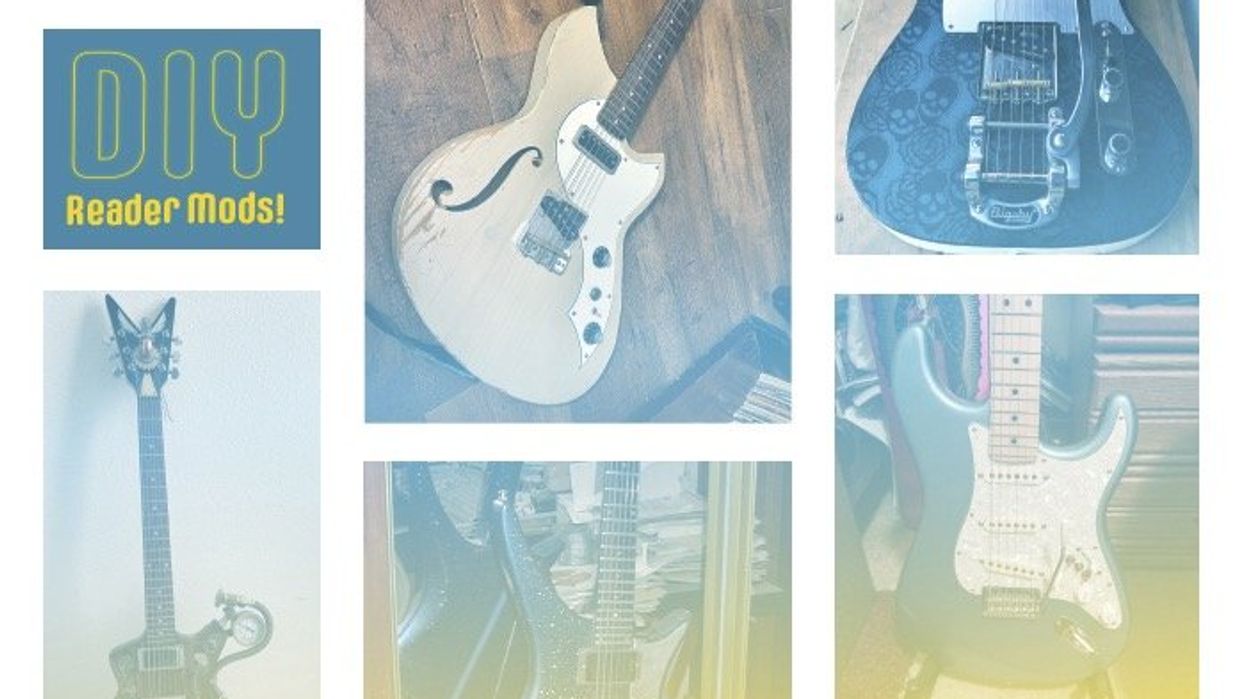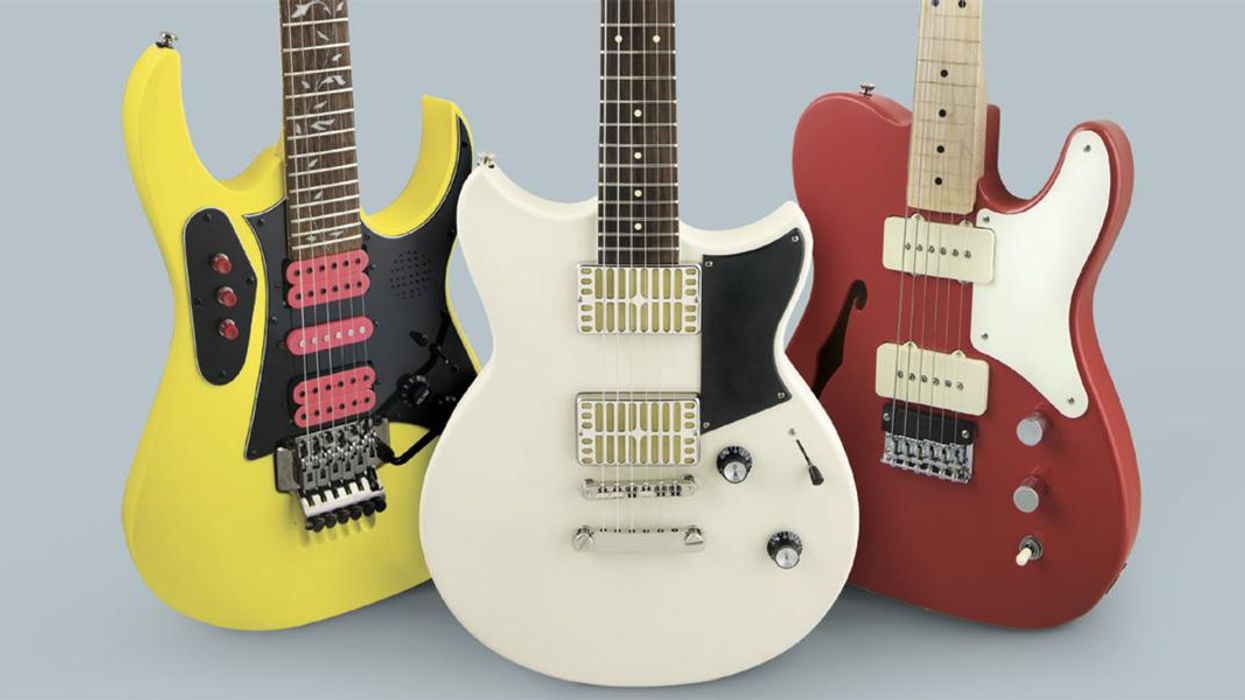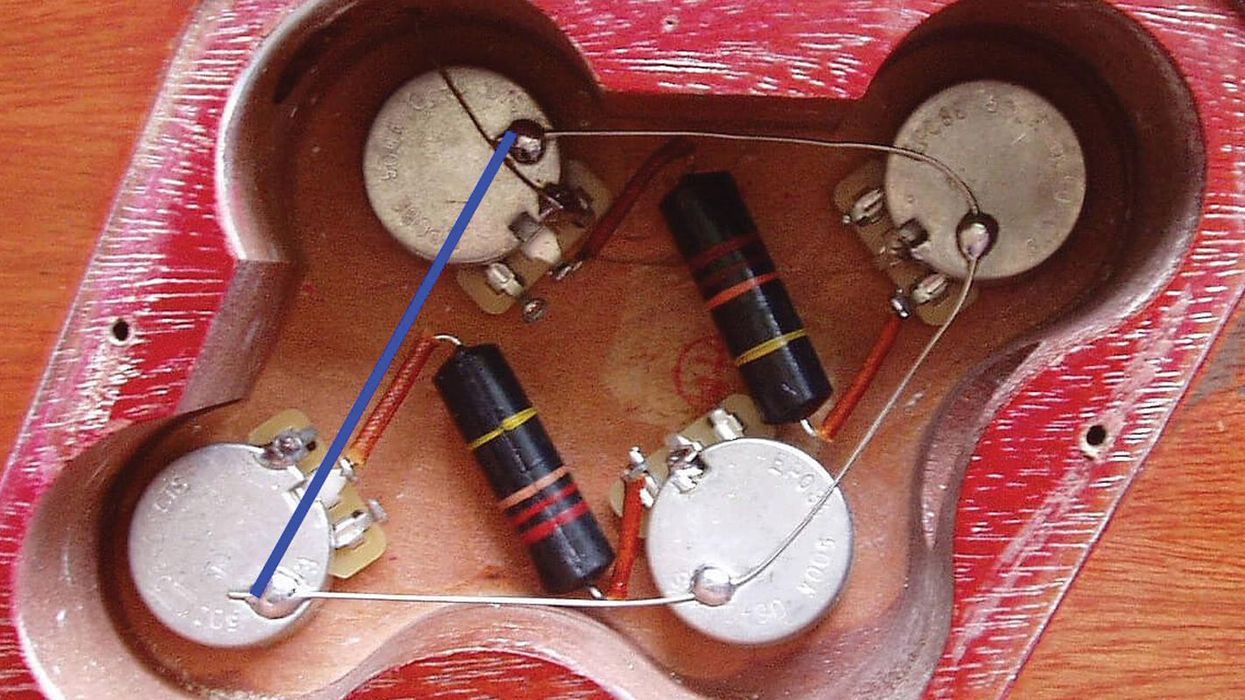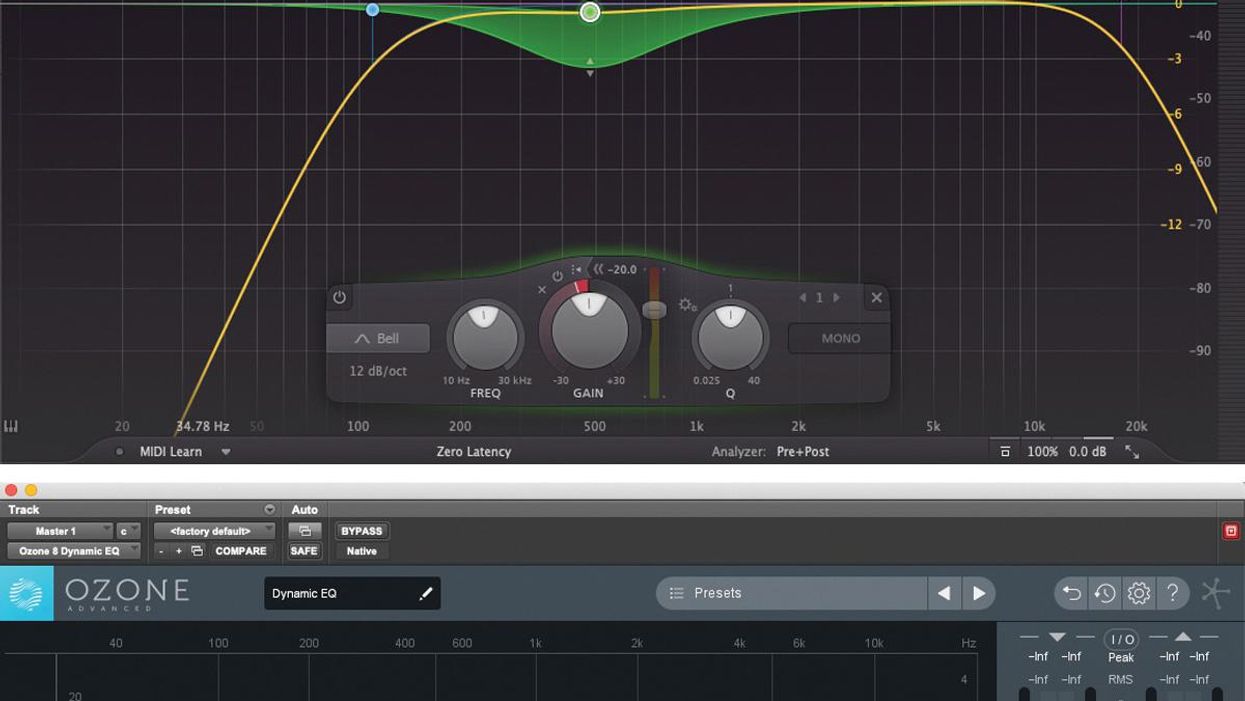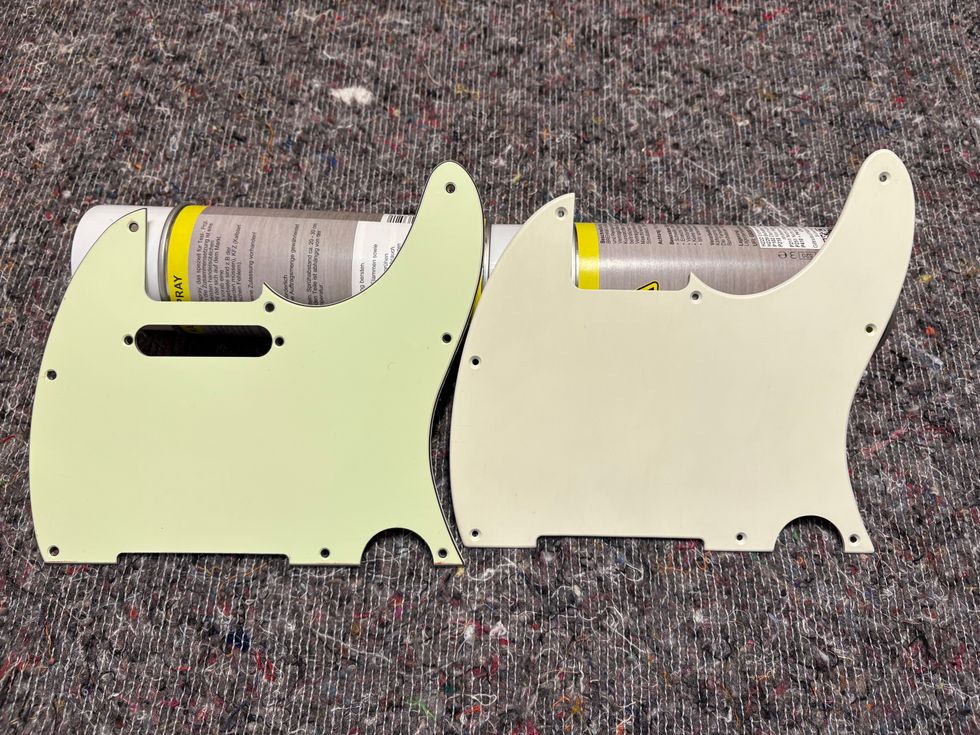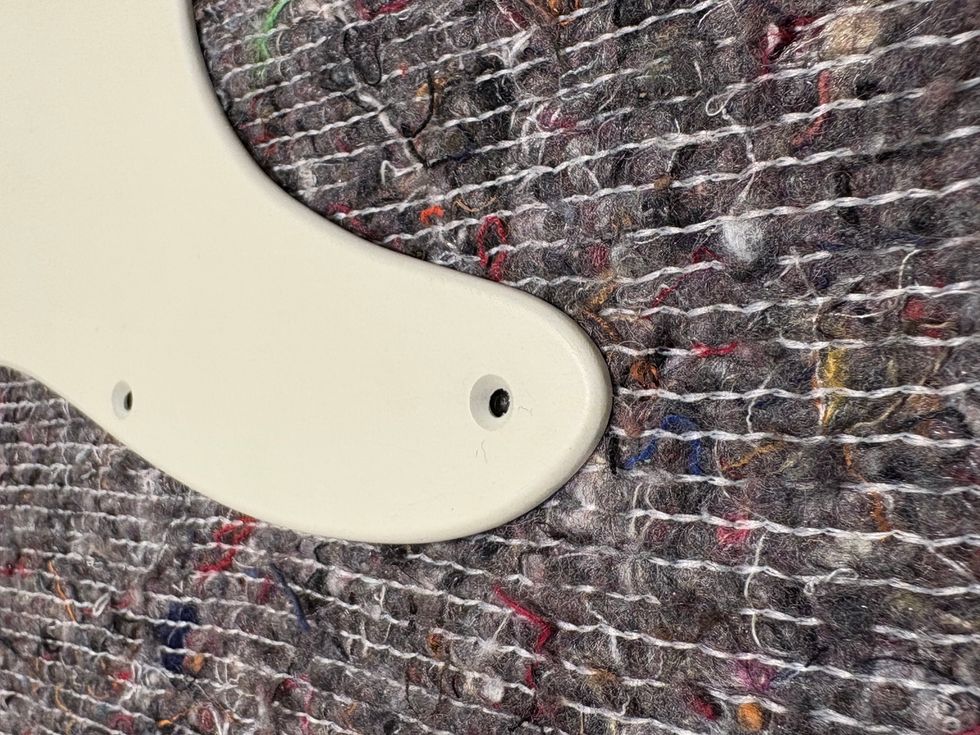As long as the air has shaken with music, there have been voyagers, troublemakers, and mindbenders who have turned our notion of harmony, melody, and rhythm on its end. Though they may not have been rewarded for their daring in their time, such giants as Igor Stravinsky, Charlie Parker, John Cage, and John Coltrane all mischievously toyed with convention. Using an orchestra, sax, piano— and even silence—they rearranged our expectations and ideas of what music can be.
If there was ever an instrument built to carry on that tradition, it’s the electric guitar. It’s a tool of a million textures and timbres and an instrument of the people. Affordable, easy to learn at an elementary level, and capable of inspiring creativity on a single string, the guitar is the perfect tool for musical revolution.
Yet somehow, amid the million-note flurries of virtuosity, hero imitation, and obsession over the instrument itself, it’s easy to lose sight of these most elegant aspects of the guitar’s potential. And lessons about cultivating an individual voice taught by geniuses from Jimi Hendrix to Pete Townshend, Lou Reed, John McLaughlin, and Nels Cline are often obscured in the stampede to retrace their steps.
Lee Ranaldo of Sonic Youth, Nick Zinner of the Yeah Yeah Yeahs, and Ben Chasny and Sir Richard Bishop of Rangda are four contemporary players that steadfastly walk the path less trodden. Though their work often takes radical, noncommercial turns, they don’t play simply to upset the apple cart. They’re all uncommonly gifted musicians, reverent students, avid listeners, and prolific in the studio. And while they each appreciate technique in measures as a means to opening doors, they are much more interested in using the guitar to kick those doors down.
The music Ranaldo, Zinner, Chasny, and Bishop make may not always be the most accessible. But the way they live their own musical and creative lives—listening adventurously, tossing the rulebook, and probing the limits of what the guitar, effects, and amplifiers can do—can help you push yourself further, no matter what music you’re trying to make.
Lee Ranaldo: The Sonic Sage
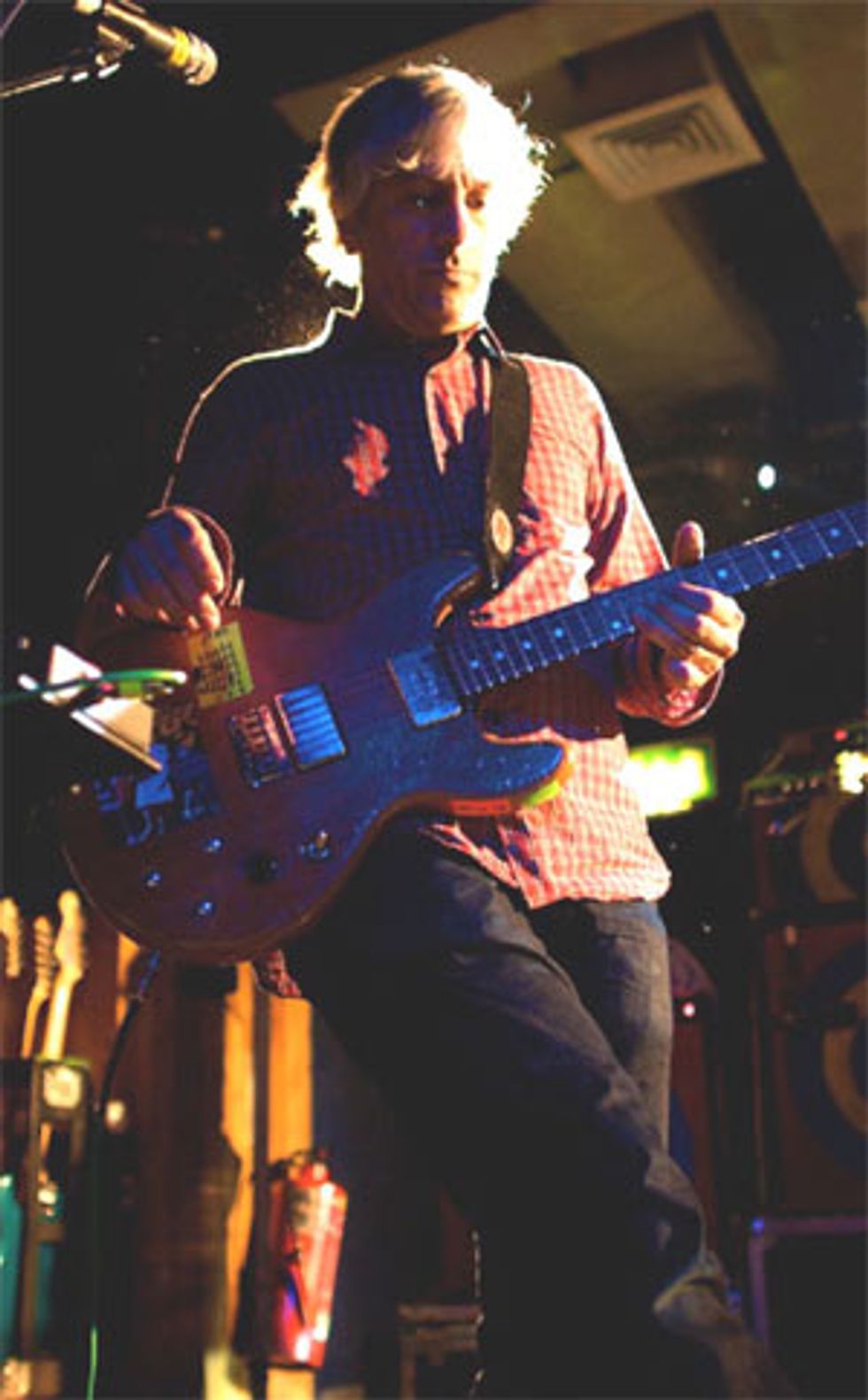 Sonic Youth’s Lee Ranaldo onstage with his Travis Bean T1000A. Photo by David Emery |
Guitarist Lee Ranaldo has been there for the whole trip. He came to New York City on the heels of the punk genesis, just in time to witness the birth of a stripped-down, confrontational, and rabid musical movement called No Wave. In 1981, he met fellow sonic adventurers Thurston Moore and bassist/guitarist Kim Gordon, and Sonic Youth was born.
Unlike many bands just finding their feet, Sonic Youth defied categorization from the beginning. They assumed the classic rock-band structure of two guitars, bass, and drums. But what they did with it sounded nothing like anything that had come before. On their first three records, the band flirted with everything from the clanging, single-chord symphonics of No Wave to the punch and power of hardcore punk and the hypnotic textures of dub and ’60s minimalism. With Evol (1985) and Sister (1986), and the barrier-shattering Daydream Nation (1988), the band was exploring an expansive and nebulous terrain where sci-fi soundscapes, sound collage, punk energy, pop art, and classic pop song structure collided.
And by the time the band signed to Geffen and delivered Goo (1990) and Dirty (1992), Sonic Youth had honed that recipe into an elegant, explosive, and beautiful musical architecture that continues to splinter into both artistically challenging and deliciously rocking songs and clatter to this day.
Along with Moore, Ranaldo is the prime mover behind the guitar explorations that support Sonic Youth’s music. And though their sound has never ceased to evolve, the component parts have remained consistent for most of their career. They use alternative tunings—usually of their own devising—almost exclusively. And their adventurous incorporation of effects, unorthodox prepared guitar techniques, and innovative use and abuse of Fender Jazzmasters and Jaguars, creates a sprawling sound spectrum ranging from the chime of fragile bells to hurricane howls.
On “Eric’s Trip” from Daydream Nation, Moore plays an inexpensive Les Paul copy strung with two .056 strings tuned to B and two .042 strings using two drumsticks—one used as a variable tension bridge and the other as a slide—to create sounds akin to hellhounds in a squadron of dive bombers. He uses a similar technique on “She Is Not Alone” from the Sonic Youth EP, but to completely different ends—using a Jazzmaster and tapping the strings with a drumstick behind his improvised drumstick bridge to create a sound somewhere between an Indonesian gamelan and a sinister, broken music box.
Ranaldo, meanwhile, is given to using screwdrivers for similar means, and he makes use of unison-based tunings, overdrive, and the considerable string length behind the bridge on Jazzmasters and Jaguars to simulate something akin to a swarm of giant, metallic, jet-powered bees. But the mélange of experimental techniques is not for show. Indeed it has helped Ranaldo and Moore crack open a universe of compositional options that produce guitar music quite unlike any that’s come before or since.
“To me, the guitar is still pretty limitless in its possibilities,” Ranaldo says. “It’s just one of the most immediate sound generators available—you can interact with it in such an immediate way. There are not many barriers between the guitar and an idea.”
Such immediacy is vital for Sonic Youth and Ranaldo, whether they’re working as a group or as participants in their many side projects. They are voracious listeners and record collectors, as well as visual artists and writers. This combination of multidisciplinary approach, communal spirit, and hard-nosed work ethic means inspiration comes fast, frequently, and in many forms. It demands an open mind and a ton of creative energy. But the payoff is a boundless playing field and countless avenues out of a rut and into the realm of unfettered musical expression.
“Collaboration is one of the coolest, most natural ways to expand on what you know," Ranaldo players, or different percussionists, I always learn something about energy level and approach. It’s one of the most incredible aspects of music—the communication that comes with creating together with someone. It’s one of the things that really sets group music apart from what an oil painter does or even a composer that does things in a more solitary way.” For conspirators and admirers alike, the key to understanding Sonic Youth’s hazy, hyperenergized, and disorienting guitar sounds is embracing the myriad alternate tunings that Ranaldo and Moore have created, mutated, and employed as the backbone of their style.
As a youngster, Ranaldo stumbled on the concept by dissecting jams by Neil Young, David Crosby, Joni Mitchell, and folk abstractionists like John Fahey. But in the hands of the Sonics, alternative tunings have become something else entirely. Octaves and unisons pumped through distortion and delay become banshee choirs and sheets of fractal blur, while odd arpeggiated intervals become crystal bells and ominous clangs of doom.
For a guitarist unaccustomed to working outside standard tuning, navigating Sonic Youth’s universe of tunings can be like starting from scratch. But as Ranaldo explains, players can create their own rules and terrain by embracing the general concept.
“The tuning thing opens up a world that’s more expansive than anything you can do with pedals,” he says. “There are such strict conventions about how you’re supposed to tune a guitar, and yet a guitar is so flexible. There’s no real reason to play in a conventional tuning if you’re trying to go somewhere new. If you can trust your ears and what you hear, you don’t have to know what a chord is to know that it’s right or sounds good. It’s a very instinctual way to play, but it opens up huge spaces to work with.
“In Sonic Youth, we’ll make note of what key we’re in for the sake of organizing a song, but we rarely know exactly what chords we’re playing—whether they’re suspended or diminished— we just know how they sound. It means working by the seat of our pants and really listening and using our ears. And what you know about the fretboard will sometimes go completely out the window, but if you’re into the exploration, it’s one of the most expedient ways to get a new flavor out of the guitar.” Ranaldo is just as willing to enter alien territory as a listener. Early fascinations with the Beatles’ and Grateful Dead’s manipulation of tape loops and electronics opened his mind to the modern minimal composition of Stockhausen and Steve Reich. And the bubbling cauldron of ’60s rock steered him to the world music he calls one of the most liberating influences on his guitar playing.
“If you’re talking about extending the potential of the guitar, international music is a really useful guide. I’ve always been inspired by Balinese gamelan music and Indian raga. But I also found a lot of parallels with that stuff and groups like the Velvet Underground or the Stooges. The overtones of raga and the way melodies can stretch out over a single note really translate on the electric guitar. So do the metallic, percussive qualities of gamelan music, which I explore by playing behind the bridge. Even things like the Master Musicians of Joujouka in Morocco. Their music is really related to circular-breathing jazz techniques on one hand, which is why Ornette Coleman went there to play with them. But they also play in these droney styles and with a repetition, intensity, and volume that equate with a lot of aspects of rock and roll. And yeah, that becomes background information when you’re working on songs in more rock-related idioms.”
Ranaldo and Sonic Youth’s openness to cross pollination is not new. Many of the same impulses fueled work by the ’60s innovators who inspired Ranaldo. But the willingness to act on ideas without second-guessing or concern for reproducing the form is what has kept Sonic Youth vital—even when it has meant diminished commercial success, battered guitars, and befuddlement among musicians unable to decode the band’s music.
“A certain irreverence is essential to getting yourself out of creative binds,” Ranaldo says. “You don’t want to get so precious about an instrument that it puts up a barrier between what you can or want to do musically. And a lot of the best art has always come from people with less-than-perfect technique. Traditionally speaking, I probably play less technically than ever before—and my sound is probably more my own now than ever.”
Lee Ranaldo’s Gearbox
Guitars: Fender Lee Ranaldo Signature Jazzmaster, Travis Bean T1000A, Fender Telecaster Deluxe
Amps: 1963 Fender Super Reverb, Fender Vibro-King
Effects: Klon Centaur Overdrive, Ibanez AD-80 Analog Delay, DigiTech PDS 1002 2-Second Delay, BJF Electronics Honey Bee Overdrive, Moog Moogerfooger Ring Modulator
Nick Zinner: The Pop Alchemist
The Yeah Yeah Yeahs busted into the collective pop-music consciousness in 2002 with the subtlety of party crashers driving a trash truck through the front door. On the surface, their music was all punky swagger and sass, served up via the formidable performing presence of vocalist Karen O. And upon a casual first listen, the music could seem primitive and buzzingly minimal. But the simplicity was deceptive.
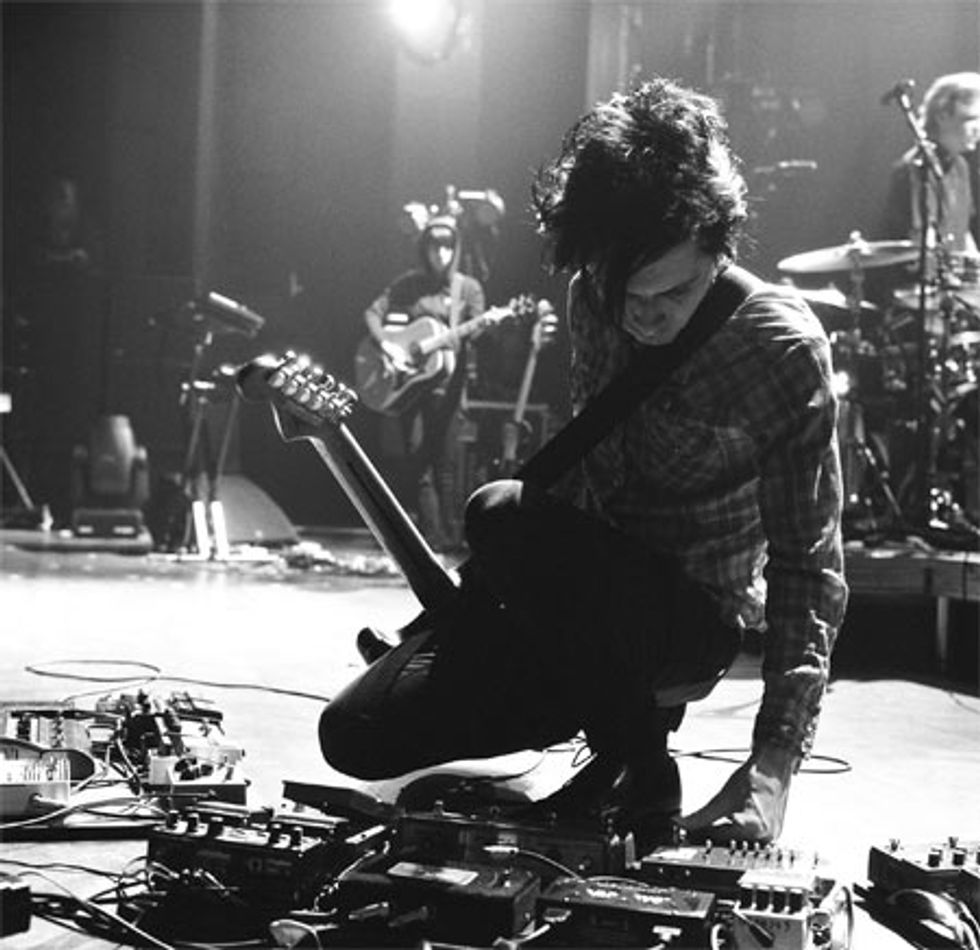
On tour with the Yeah Yeah Yeahs’ in 2009, Nick Zinner tweaks one of his three pedalboards stocked with Line 6, Boss, Electro-Harmonix, Foxx, DigiTech, and other pedals (as well as a Voodoo Lab Pedal Power) as rhythm guitarist Jessica Dobson looks on. Photo by David Belisle
At the root of the aural ruse was the exuberant, inventive, and resourceful playing of guitarist Nick Zinner. And if a few deeper listens of any of their first two EPs or full-length LP didn’t hip the casual listener to that fact that Zinner was an uncommonly clever guitar player, arranger, and texturalist, seeing one of the band’s high-octane shows usually obliterated any doubt.
Though they have occasionally augmented the band with an additional guitarist or keyboard player, Zinner and drummer Brian Chase are the band’s only instrumentalists. It’s an arrangement that keeps Zinner on his toes in the live context. But it also gives him plenty of room to create the dynamic, driving buzz and howl that sets the Yeah Yeah Yeahs’ sound apart. And in a single song, Zinner can juxtapose frantic, off-kilter lead lines with hooks and riffs worthy of Zep or the Buzzcocks, and create moods that move from melancholy to frenzied—all while displaying a remarkable empathy for the expressive power of Karen O’s voice. Their sound and success are a testament to the creativity that can be sparked by limitations. And few guitarists are doing that as craftily as Nick Zinner.
“It changed everything,” says Zinner about the eye-opening experience of working in the context of a smaller band. “When the Yeah Yeah Yeahs first started, I was playing in a more traditional five-piece band. When Karen and I started writing rock songs, I was going against the full-band approach. I was really trying to do everything, and cover the entire aural spectrum of a full band. Despite our minimalism, we were always thinking maximum.”
Zinner was well prepared for the challenge of covering so much ground on his own. Early experiences with acoustic guitar, violin, and heavy metal gave Zinner a wide spectrum of musical reference. And the disciplined thumping of jazz-schooled drummer Chase created a solid rhythmic foundation from which Zinner could concoct the Yeah Yeah Yeahs’ more melodic personality.
He also drew influence from guitarists who took more adventurous and inventive routes around the constraints of small groups and primitive musical forms, favoring players in stripped-down settings who pursued outside-the-blues-box techniques.
“Nick Cave always had the best guitar players for me,” says Zinner, reflecting on some of the minimalists/maximalists that helped illuminate his way. “Rowland Howard from the Birthday Party, and Blixa Bargeld from the Bad Seeds and Einstürzende Neubauten were making sounds so minimal and direct, while being totally weird. I liked those first three U2 records too, and what the Edge was doing with delay and textures. He was sort of showing off and hiding at the same time. And Sonic Youth were making such a bizarre sound while still rocking out.”
For Zinner, an Edge-like zeal for imaginative use of effects pedals was a first step toward filling out the blank spaces in the Yeah Yeah Yeahs’ architecture, and creating a sonic signature for the band. Chains of loopers, delays, and fuzz tones not only helped Zinner add girth to the band’s sound, but also became essential compositional tools. These pedals allowed Zinner to create spiky, repeated riffs over which he could play melodic hooks or counter-melodies to Karen O’s vocal lines.
On the band’s breakthrough “Maps,” for instance, Zinner plays and stores a simple 32nd-note pattern in a Line 6 DL4 delay that he summons repeatedly throughout the song—building dynamics and tension almost like an orchestra conductor. It’s a startlingly effective technique.
“Most of what I’ve done is totally dependent on effects,” Zinner says. “But I think its good to switch things up, as difficult as that can be. There are a few instances on the last two Yeah Yeah Yeahs’ records where I would either play acoustic guitar or plug straight into the board. At first, it was a lot like the dreams where you find yourself naked in a crowd.” Such sentiments might reflect the anxiety that’s inherent to changing direction in a still blossoming career. But Zinner is committed to reinvention. “I’m usually doing something between what I know and what I’m striving to achieve. I have no idea what, if anything, people expect from me. Instinct has to come first. I’ll put in a considerable amount of time working on a part, but usually my first idea is the best one.”
Nick Zinner’s Gearbox
Guitars: Mid-’80s “E” Series Fender Stratocaster, First Act Nick Zinner Signature Delia
Amps: Fender Hot Rod DeVille 212, Fender Twin Reverb
Effects: Line 6 DL4 Delay Modeler, DigiTech JamMan, DigiTech Whammy, Foxx Tone Machine, Electro-Harmonix POG
Ben Chasny and Sir Richard Bishop: The Subterranean Travelers
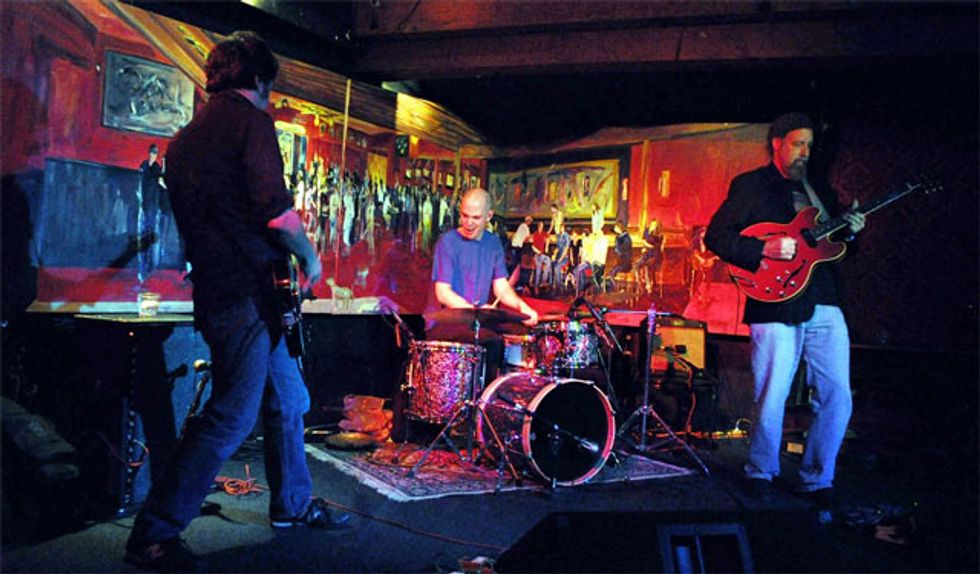
Chasny, Corsano, and Bishop raging onstage with Rangda. Photo by Joe Mabel
One of the most exciting developments in music—guitar or otherwise—over the last decade has been the rise of the American free-rock underground. Loosely linked through the web and a network of small independent labels, clubs, and show promoters that take their inspiration from the punk and post-punk movements of the ’70s and ’80s, this experimental movement is a fluid and inclusive environment that defies classification. And Ben Chasny and Sir Richard Bishop are two of the most daring and respected instrumentalists working within its gloriously loose parameters.
Though they currently perform together with powerhouse improvisational drummer Chris Corsano in the underground supergroup Rangda, Chasny and Bishop have played relentlessly as solo artists and band members.
Along with his brother Alan, Bishop led the bewilderingly creative and prolific Sun City Girls—a fast moving target of a band that stirred up a ramshackle brew of free jazz, noise rock, psychedelia, and twisted Gypsy virtuosity that mowed down live audiences in performance. More recently, he crafted several albums on his own that interpret, among other things, Middle Eastern traditional and pop music through a mutated Django-meets-Quicksilver Messenger Service guitar delivery.
Chasny, meanwhile, leapt into the fast-moving underground stream via membership in the San Francisco-based high-energy combo Comets on Fire and his Six Organs of Admittance project—a constantly evolving vehicle for his delicate and fiery fingerstyle acoustic work and visceral electric playing that unites everything from folk-rock to lo-fi organic ambiance and ecstatic freestyle noise assaults. Both Bishop and Chasny see the electric guitar as limitless in the hands of those willing to get out of their comfort zone. And as their improvisations and more structured material with Rangda attest, they are fearless in stretching the constraints of a song and the relatively simple guitar, effect, and amplifier rigs they use. Indeed, players seeking enlightenment about how to make the guitar a more emotive tool with their own two hands need look no further than Rangda.
“I think it helps to listen to players that use the entire guitar,” says Chasny about unlocking untapped potential in a 6-string. “People like Keith Rowe and Donald Miller open up the entire sonic palette of the guitar with tools and make you realize how many possibilities there are. You can do anything from the cleanest folk strum to extreme prepared stuff. And there is also a dynamic in there that allows you to explore subtleties within a single bent note— like Richard Thompson’s playing, for instance.” Bishop is even more adamant about stretching technique and working outside the bounds of what’s comfortable. And though a listen to any one of his recent solo works will reveal that Bishop is capable of incredibly technical playing— from precision staccato picking to frenzied multiple-octave scale runs—he regards technique for the sake of technique and the quest for perfect tone as dead ends.
“You always hear about specific players and their search for the perfect tone,” says Bishop, reflecting on the obsessive tendencies of some guitarists. “So what happens when they find that ultimate tone? Is that it? When it comes to technique, a similar problem rears its head. It doesn’t matter how much technique anybody has. There are thousands of players out there who have mastered the fretboard inside and out. They can play every chord a 100 different ways and with every possible fingering. They’ve mastered every scale and mode known to man, and their fingers can stretch from here to the moon. That doesn’t mean they are going to play anything new or challenging or different.”
Chasny and Bishop are avid listeners and students of music—esoteric and otherwise. Bishop and his brother Alan participate in running Sublime Frequencies, a record label that specializes in unearthing obscure ethnic music that includes everything from Egyptian guitar heroes to East Asian pop radio broadcasts. But while they’ll readily rattle off lists of influences from Jimi Hendrix, Sonny Sharrock, Donovan, and Jimmy Page to the keyboard playing and sax work of Marshall Allen and John Coltrane, Chasny and Bishop both find value in a clean slate.
“The most important element in my playing now is keeping my mind clear and ready for anything,” says Chasny. “The clearer my mind, the better I am able to improvise. If my mind is focused on something else, I tend to fall back on patterns or sleepwalk my way through a set.”
Bishop echoes those sentiments, applying them not only to performance, but also to his most ordinary interactions with the instrument. “There was a point early on when I made a conscious decision to avoid teachers and lessons, and stop trying to play like my favorite guitar players. That led to a personalized approach and resulted in a lot of experimentation and freeform playing. It wasn’t pretty at first, but it was a major turning point for me. Now I have a revelatory experience with the guitar every time I pick it up. Each day, I’ll just start playing something and create a three- to five-minute piece without any preconceived plan or desired outcome. Doing this instantly forces me into a creative situation, and the end result is always a surprise.”
Ben Chasny’s Gearbox
Guitars: Fender Telecaster Custom, K. Yairi orchestra-style acoustic with a cutaway
Amps: Fender Twin Reverb
Effects: Boss DS-1 Distortion
Sir Richard Bishop’s Gearbox
Guitars: 1960 Gibson ES-330, Dell’Arte Dark Eyes Selmer-style acoustic
Amps: Various Fender and Vox tube amps
Effects: Boss RC-20XL Loop Station, Line 6 Verbzilla
Moving Forward
If there’s one thread that runs through the philosophies of Ranaldo, Zinner, Chasny, and Bishop, it’s that moving beyond guitar clichés and stylistic traps is a conscious decision that has to be followed by a largely unconscious approach to the instrument. It’s a paradoxical position from which to work. But as each of these artists proves, it can be a fruitful creative process especially when you’re willing to put in the time.
“Players need to get sick of what they are playing and what they are listening to, and have the will to do something about it,” explains Bishop. “And it takes work. If you want to get different or new sounds from the guitar—sounds that you haven’t gotten before—then do things differently. Do the opposite. Alter your approach. Try a little dissonance, use more upstrokes with chords if you use mainly downstrokes, and create your own new chord forms. Train your ears to hear things in a different way. Think about what Thelonious Monk did with the piano— there were no effects, just a unique combination of dissonance, harmonic oddities, and whatever else he could muster. The same ideas can be applied to the guitar, though it may take your ears a while to process unfamiliar sounds in a different way. But it can be done. Just do whatever you can to come up with something new.”
Seven Songs of 6-String Enlightenment
Sonic Youth
“Expressway to Yr Skull” from the 1986 album Evol
Neil Young allegedly called this the greatest guitar song ever and has praised the beauty of its melody and ferocity in live performance. Here Lee and Thurston Moore create a gorgeous cathedral of sound in EG#EG#EG# that evokes the ringing of church bells and a raging cyclone in a single song.
“Diamond Sea” from the 1995 album Washing Machine
Perhaps the crown jewel of the Sonic Youth canon, “Diamond Sea” is also one of Sonic’s most psychedelic pieces. Like “Expressway,” it’s as beautiful, moody, muscular, and melodic a piece of guitar music as you’ll ever hear—moving from a haunting, four-note figure through a spiraling melody and punctuated by a 10-minute outro that sounds like a supernova tearing at the very fabric of the cosmos.
“What We Know” from the 2009 album The Eternal
Lee Ranaldo takes the vocal lead on this textbook example of an infectious power-pop tune turned inside-out with driving and howling verse intros and bridge—a Sonic Youth specialty that’s also on glorious display on tunes like “Kool Thing” (Goo, 1990) “Sugar Kane” (Dirty, 1992), and “Sunday” (A Thousand Leaves, 1997).
Yeah Yeah Yeahs
“Date with the Night” from the 2003 album Fever to Tell
A powerhouse that showcases Zinner’s sense of composition, his capacity to pack multiple unorthodox hooks into a single song, and his knack for playing off Karen O’s distinctive singing style.
“Maps” from the 2003 album Fever to Tell
This is the song that broke the YYYs to a wider commercial audience. “Maps” showcases Zinner’s inventiveness as an arranger, with a looper-sampled section, pulsing new-wave skank sections in the verses, a tender vocal melody, and a buzzing, punch-in-the-gut bridge.
Ben Chasny and Sir Richard Bishop
“Shelter from the Ash” from the 2007 Six Organs of Admittance album
This cut from Ben Chasny’s Six Organs of Admittance project combines a hypnotizing, circular acoustic riff with beautifully raging, slashing, and lyrical electric lead work that’s intensely personal, yet as big as the sky.
“Plain of Jars” from the 2010 Rangda album False Flag
A deceptively simple, 15-minute-plus meditation that evokes dew drops, a quiet dawn, and an exploding fireworks factory over its span. Neither Chasny nor Bishop are at their most radical here (check out the album’s opening cut, “Waldorf Hysteria,” for a taste of that), but they are at their most resourceful, illuminating the simplest themes with subtle variation and demonstrating amazing empathy for each other and drummer Chris Corsano.



